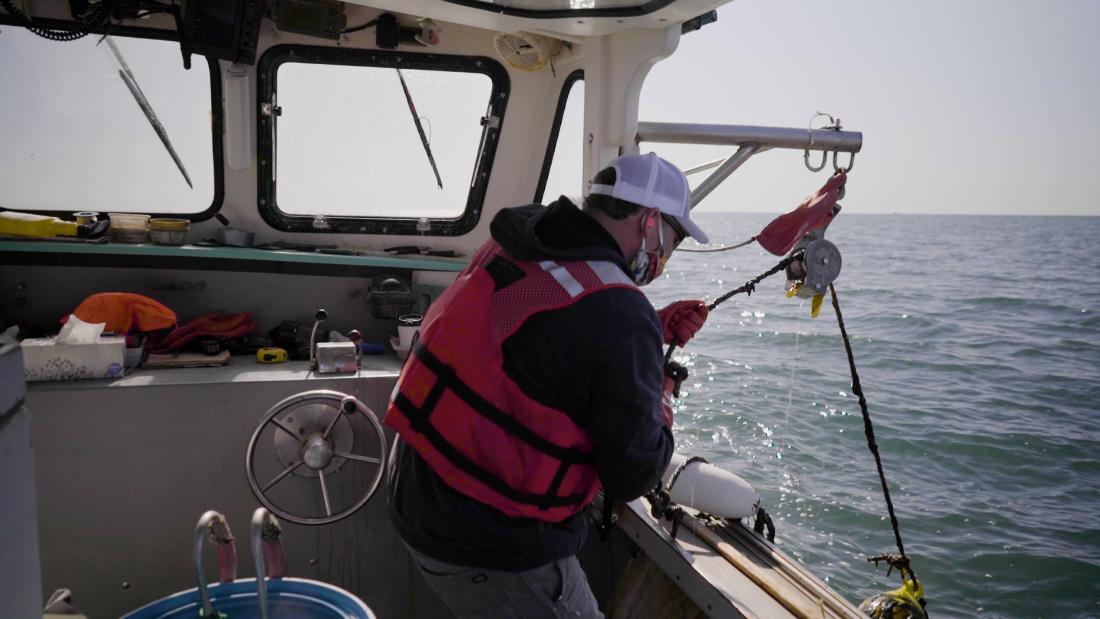Running Tide Founder Marty Odlin, a Dartmouth graduate and engineer whose household consists of generations of fishermen, is working with a staff of engineers, software program builders, oceanographers, maritime professionals, information scientists and hatchery technicians to bury huge quantities of kelp at the backside of the ocean. Odlin is aiming to “restore and then accelerate that natural process” of seaweed absorbing carbon from the environment, he informed CNN Business.
“Kelp is one of the fastest growing things in the world, so it pulls carbon in at the fastest rate of any species in the world,” Odlin stated. From his uncle’s re-purposed lobster boat, he and his staff use ocean currents to transfer the kelp to deep water the place it might be sunk. Gravity then places the kelp below large strain as it sinks to the deep ocean.
The seeds are grown in a hatchery, and as soon as matured, the staff places the kelp into biodegradable buoys. As it grows, the plant ultimately turns into too heavy for the buoy and sinks to the backside of the ocean the place the huge water strain pushes it into the sea flooring. “After the kelp grows, the biodegradable buoy will dissolve and lose its buoyancy and everything will sink to the ocean bottom,” Oldin informed CNN. “The ocean is a tremendous natural carbon sink,” he added.
But that is no easy activity, he acknowledges. “The intentional removal of eight hundred gigatons of carbon from the atmosphere will probably be the biggest engineering challenge in human history,” Odlin stated. “It’s essentially running 150 years of the oil industry in reverse in 15 years.”
Odlin is working with scientists and universities to accumulate information to make sure that carbon is getting eliminated. “The positives for growing kelp is that it grows remarkably fast and the deep water environments it sinks to have really low temperatures which can limit decomposition back to carbon dioxide,” Peter Raymond, a professor of ecosystem ecology at Yale, informed CNN Business.
Carbon sequestration has been a sizzling matter for a while, however the conversations surrounding the methodologies have picked up as the Biden administration focuses on combating local weather change and creating clear vitality applied sciences.
“There are a lot of really progressive companies out there that want to minimize their carbon footprint and we can sell the carbon removal service to those companies,” Odlin stated of Running Tide’s overarching enterprise technique. When an organization buys a carbon elimination credit score from Running Tide, Odlin and his staff take away the carbon for them to offset the carbon they’re emitting to run their enterprise.
E-commerce platform Shopify is Running Tide’s first large buyer for carbon elimination credit. Stacy Kauk, the director of Shopify’s sustainability fund informed CNN Business she was stunned to study that Running Tide wasn’t “relying on expensive equipment or energy-intensive processes, and yet their solution has huge potential for combating climate change.” Shopify can also be serving to Running Tide scale and commercialize their know-how and create extra partnership alternatives.
“Making it cheaper for businesses to invest in carbon capture and storage is the best way to immediately reduce fossil fuel emissions,” stated Sally Benson, co-director of Stanford Energy’s Precourt Institute.
The timing is pressing. “This is like an incredibly important crisis, and every year matters,” Odlin stated. “Every year we allow this carbon in the atmosphere, the world warms up.”







